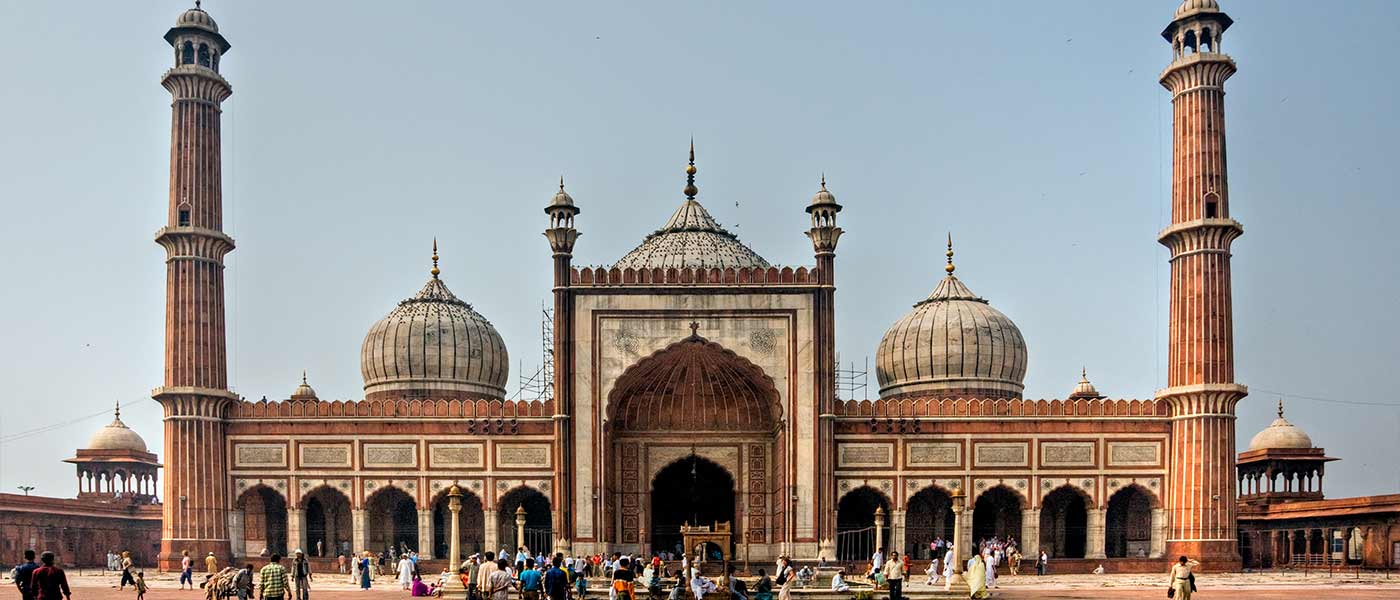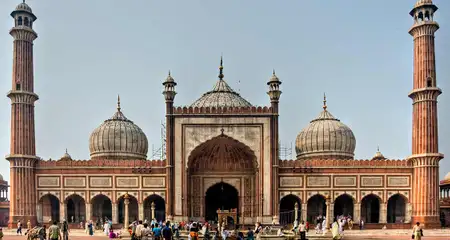The Jama Masjid in Delhi is often referred to as the most magnificent mosque in India and for all the right reasons. Located in the heart of Old Delhi, this 17th-century colossal edifice represents the architectural extravaganza of Mughal Emperor Shah Jahan. Such is the popularity of the mosque that a trip to the national capital cannot be deemed complete without a visit to it.
Want to know more about this top heritage monument in Delhi? This blog tells you everything you should know, such as the history, architecture, timings, entry fee, and other interesting details about Delhi Jama Masjid.
Delhi Jama Masjid Quick Info
| Location | Off Netaji Subhash Marg, Chandni Chowk |
| Type | Mosque |
| Also Known as | Masjid-i Jahan-Numa |
| Masjid Timings | 7:00 am to 12:00 pm and 1:30 pm to 6:30 pm; every day (tourists not allowed during the prayer hours) |
| Minaret Timings | 9:00 am to 5:30 pm |
| Masjid Entry Fee | Free |
| Minaret Entry Fee | ₹ 100 |
| Camera Charges | ₹ 300 |
| Nearest Metro Station | Jama Masjid Metro Station |
| Commissioned by | Shah Jahan |
| Year of Establishment | 1656 |
| Cost of Construction | 1 million rupees |
| Architectural Style | Indo-Islamic and Mughal |
| Material Used | Red sandstone and white marble |
| Status | A mosque and a tourist place maintained by Delhi Waqf Board |
Delhi Jama Masjid: History
It was Shah Jahan who built the Jama Masjid in the walled city of Shahjahanabad (or Old Delhi as it is known today), which was the capital of the Mughal Empire during his reign. The construction of the mosque began in 1644 and went on for long twelve years before it was completed in 1656. More than 5000 workers were engaged in the construction work, supervised by Saadullah Khan, the prime minister of the Emperor. Shah Jahan spared no expenses to build this grand monument and it was built at a cost of one million rupees.
Initially, the mosque was named Masjid-i-Jahan Numa, which means ‘the Mosque that Reflects the World’. Later, it came to be known as Jama Masjid or the Friday Mosque. The inauguration of the mosque took place on 23 July 1656 by an Imam named Abdul Ghafoor Shah Bukhari, who came all the way from Bukhara (now Uzbekistan) at Shah Jahan’s invitation. He was also appointed the first Shahi Imam of the mosque by Shah Jahan.
Since its construction, the masjid has been standing tall in the city right next to another iconic monument built by Shah Jahan, namely the Red Fort. Till the end of the Mughal era, it was the royal mosque of the emperors. After the Revolt of 1857, the victorious British rulers seized the mosque with the intention to destroy it. However, strong opposition from the public made them reconsider this decision and the structure was spared any damage. Currently, the masjid is under the control of Delhi Waqf Board.
Delhi Jama Masjid Architecture
The Jama Masjid in Delhi is considered to be the finest mosque constructed during the Mughal Empire. Built using red sandstone and white marble in Indo-Islamic architectural style, it has a length of about 261 feet and a width of 90 feet. The structure is adorned with three huge arched gates, three marble domes, four towers, and two towering minarets. It also has a sprawling courtyard that can accommodate more than 25,000 people for prayers at a time.
Out of the three gateways to the mosque, the one on the eastern side has 35 steps leading to it. This gate is also known as the royal entrance since it was reserved for use of Mughal Emperors. The gates on the northern and southern sides have 39 and 33 steps, respectively. Each of the two minarets comprises of five stories with a protruding balcony and reaches up to a height of 130 feet. There are 130 steps inside each minaret to climb to the top.
The mosque has a strikingly designed black and white marble floor with 899 bordered spaces demarcated for worshippers. Lavish arches, floral designs, and fluorescent motifs adorn the interiors of this mosque. The archway to the center of the prayer hall has the words ‘The Guide’ written on it. The significant relics at the mosque include a copy of the Quran written on deerskin, a red hair from the beard of Prophet Mohammed, a pair of his footwear, and his footprints on a marble block.
Delhi Jama Masjid: Today
Today, this centuries-old mosque is one of the top tourist places in Delhi. Counted among the largest mosques in the country, it draws travelers and devotees from all corners of India and beyond. The mosque witnesses a huge congregation of worshippers during Id when people gather here to offer prayers or namaz. Though there are two minarets inside the mosque, only the one at the southern end is open to the public at a nominal fee. During the evenings, the mosque is illuminated, making it a sight to behold.
You need to dress appropriately to enter the mosque. And if you have come unprepared, robes can be hired at the northern gate.
Lesser Known Facts about Jama Masjid, Delhi
- The masjid is one of the last architectural marvels built by Shah Jahan.
- During Shah Jahan’s time, the eastern gate was used by him to access the mosque. The northern gate was meant to be used by the nobles while the southern one was open for the common people.
- Shah Jahan’s son Aurangzeb drew inspiration from this mosque when designing the structural plan for the Badshahi Masjid in Lahore.
- Before the Revolution of 1857, the mosque housed a madrasa within its premises. During the revolt, it was destroyed.
- In 1948, the last Nizam of Hyderabad was approached for a donation of 75,000 rupees for restoration works of one-fourth of the structure’s floor. The Nizam donated 3 lakhs rupees instead, specifying that the whole mosque floor to be renovated so that no portion should look old.
- Contrary to the popular belief, Delhi Jama Masjid is not the largest mosque in India. The Taj-ul-Masjid in Bhopal, with a capacity of 175,000 people, tops the list.
- The masjid is in straight line of Connaught Place & Parliament House
Attractions near Jama Masjid, Delhi
- Chandni Chowk Market (220 m)
- Shri Digamber Jain Lal Mandir (750 m)
- Red Fort (1 km)
- Fatehpuri Masjid (1.7 km)
- Gurdwara Sis Ganj Sahib (2.1 km)
- Gauri Shankar Mandir (2.4 m)
- Stephen’s Church (2.6 km)
- Raj Ghat (2.7 km)
- Khari Baoli Spice Market (2.8 km)
- India Gate (6.1 km)
- Humayun’s Tomb (9.9 km)
Things to Do near Delhi Jama Masjid
If you are a foodie or shopaholic, there are a lot of interesting things to do near Jama Masjid in Delhi. For instance, don’t leave the area without digging into the heavenly kebabs at some of the iconic eateries located near the mosque. You can also indulge in some shopping in the Chandni Chowk market in Delhi. The top eating and shopping places near Delhi Jama Masjid include:
- Aslam Chicken Corner for butter tikka chicken
- Qureshi for kebabs
- Cool Point for desserts
- Kinari Bazaar for wedding shopping
- Dariba Kalan Market for jewelry
- Nai Sarak for books
- Khari Baoli for spices
There’s no denying that the Jama Masjid is one of the best historical places to visit in Delhi to get a glimpse into the Mughal splendor. Now that you know everything about Delhi Jama Masjid, why not keep aside half a day of your itinerary to visit it and also indulge in some food and shopping?



























